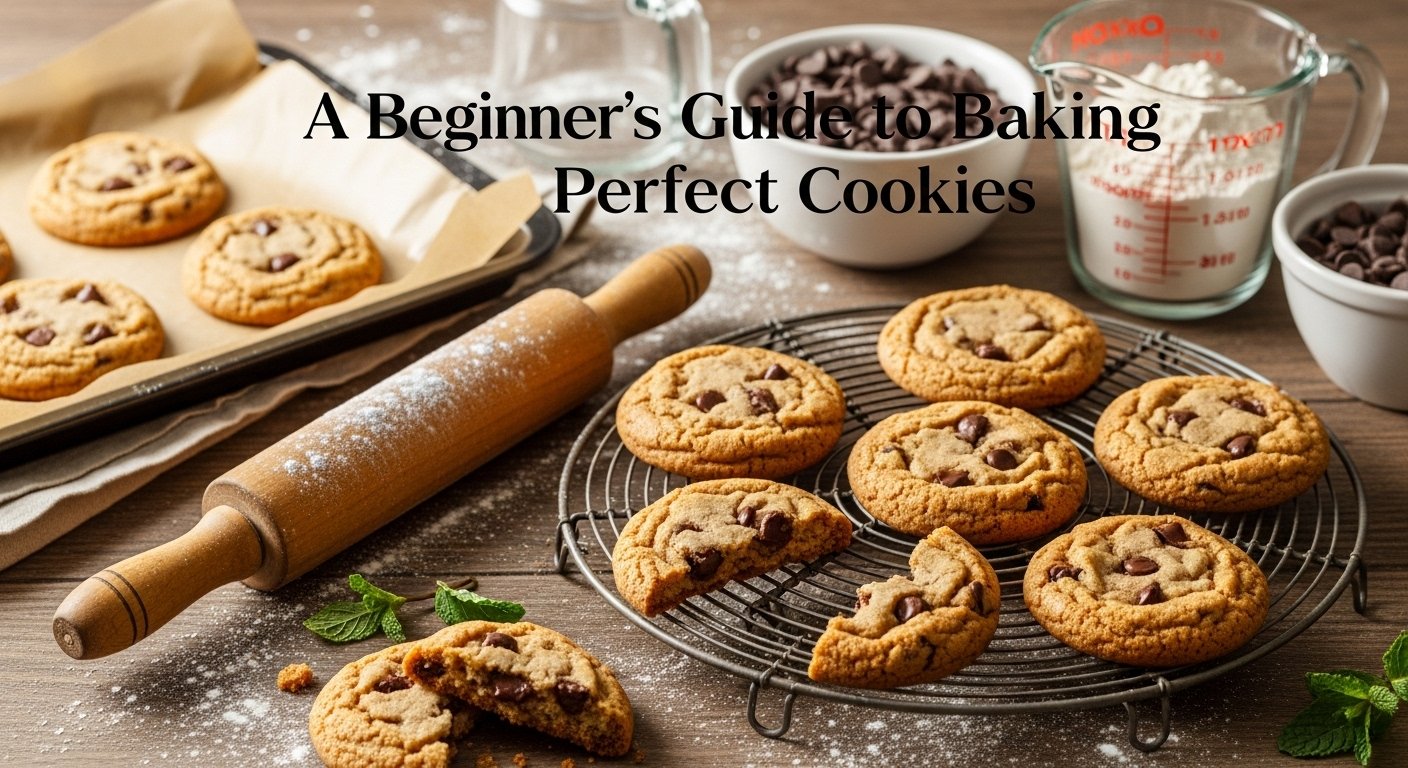Do you dream of warm, chewy cookies fresh from the oven, but feel intimidated by the baking process? You’re not alone! Many aspiring bakers wonder how to bake cookies for beginners. Baking, especially for delicious cookies, might seem like a complex science at first. However, with the right guidance, anyone can master the art of creating perfect, golden-brown treats. In fact, baking at home remains a popular activity, with 11% of people surveyed baking at least once a week and 20% baking monthly as of January 2025. This shows a real passion for homemade goodies. Cookies, identified as the most popular sweet treat among US Americans, hold a special place in our hearts and kitchens. This guide will walk you through everything you need to know to confidently bake perfect cookies, from essential tools to troubleshooting common mistakes.
Even as busy schedules lead many consumers to opt for convenient alternatives like pre-packaged cookie doughs or mixes, the satisfaction of a scratch-baked cookie is unmatched. Over one in ten Americans consume cookies multiple times daily, with consumption frequency on the rise. This guide helps you tap into that joy! By the end of this article, you will understand the fundamental techniques, common pitfalls to avoid, and simple recipes that guarantee success for any beginner. Get ready to transform your kitchen into a cookie-making haven!
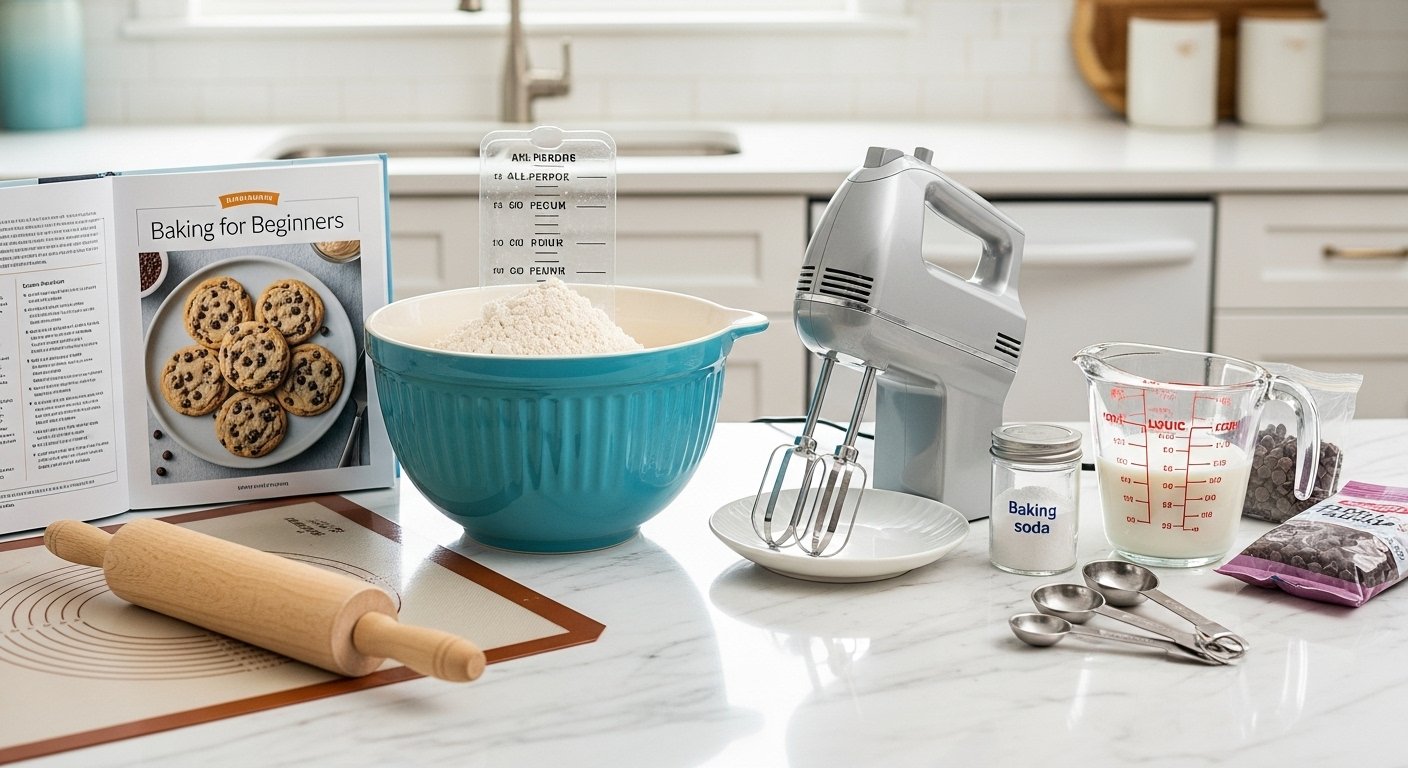
Your Essential Toolkit for Cookie Baking Success
Embarking on your cookie baking journey requires a few fundamental tools. Luckily, you probably already own most of them. Having the right equipment makes the process much smoother and more enjoyable. So, what are the essential tools for baking cookies?
Basic Kitchen Utensils
You don’t need fancy gadgets to start. A good set of measuring cups and spoons is crucial for accuracy. Additionally, you’ll need at least two large mixing bowls, a sturdy whisk, and a rubber spatula for scraping down the bowl. An electric mixer, either a hand mixer or a stand mixer, can certainly make creaming butter and sugar much easier, saving your arm some work. You will also need a wire rack for cooling your freshly baked cookies.
Baking Sheets and Parchment Paper
Invest in good quality baking sheets. Flat, light-colored sheets promote even baking and prevent over-browning. Parchment paper is a true game-changer in cookie baking. It prevents sticking, ensures easy cleanup, and helps cookies bake uniformly. Simply line your baking sheets with it before scooping your dough. Moreover, a cookie scoop ensures consistent cookie sizes, which is key for even baking.
The Importance of Accurate Measuring
Baking is often described as a science, and for good reason! Precision in measuring ingredients is paramount for consistent results. Why is measuring ingredients accurately important for baking cookies? Using too much flour can lead to dry, crumbly cookies, while too little can make them spread excessively. Similarly, an incorrect amount of sugar or fat dramatically alters texture and taste. Always use dry measuring cups for dry ingredients and liquid measuring cups for liquids. For the most accurate results, especially with flour, many experienced bakers recommend using a kitchen scale to measure by weight. It truly makes a difference in your final product.
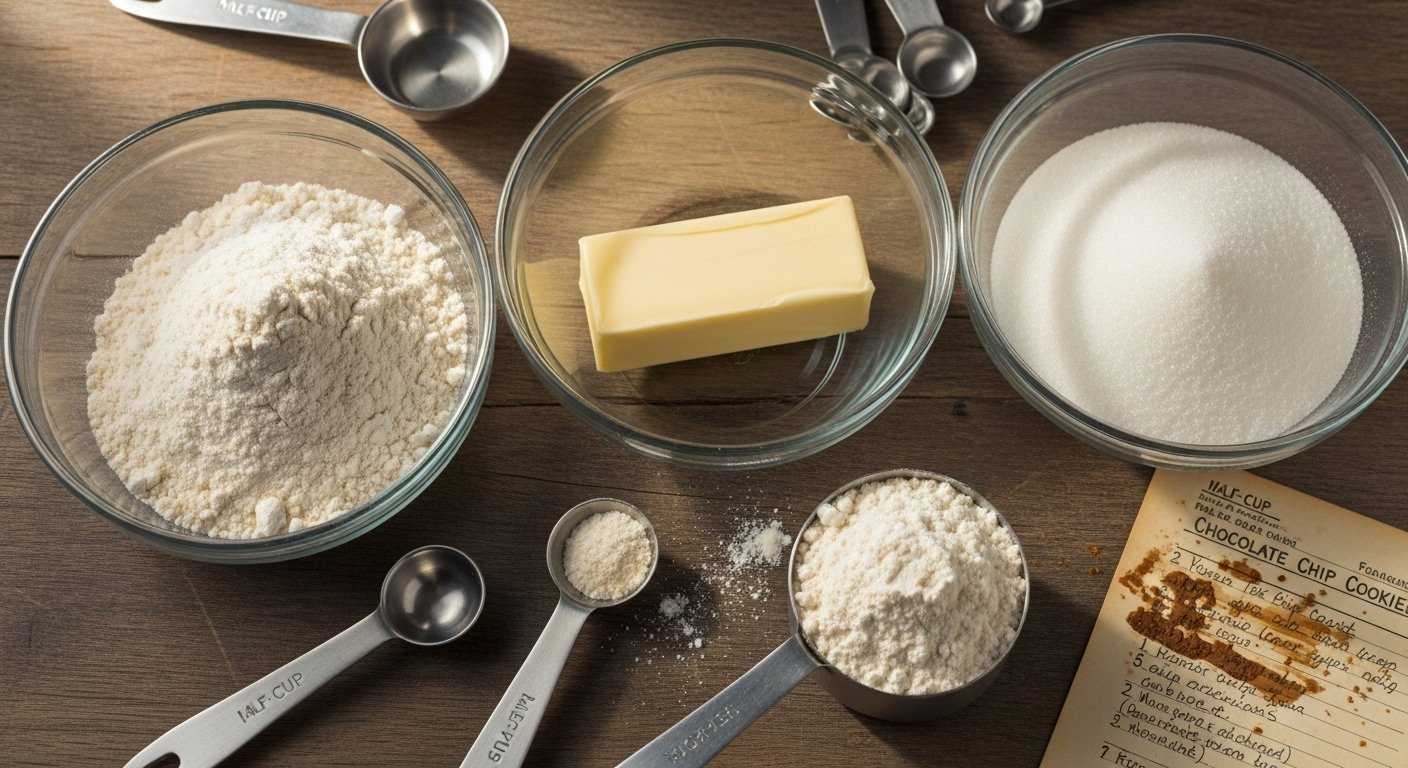
Master the Building Blocks: Basic Ingredients for Perfect Cookies
Understanding the role of each ingredient is fundamental to becoming a great baker. So, what are the basic ingredients for cookies? Most cookie recipes rely on a core set of ingredients, each contributing uniquely to the cookie’s structure, flavor, and texture.
All-Purpose Flour: The Structure Builder
All-purpose flour forms the backbone of your cookies. It provides the necessary structure, holding everything together. For many recipes, sifting your all-purpose flour isn’t always necessary, but it helps aerate it and remove any lumps. Always measure flour correctly, either by spooning it into your measuring cup and leveling it off or, ideally, by weight.
Unsalted Butter: The Flavor Foundation
Unsalted butter is preferred in baking because it gives you control over the salt content. It adds richness, flavor, and contributes significantly to the cookie’s texture. Always use high-quality butter for the best taste.
Sugars: Granulated and Brown Sugar
Both granulated sugar and brown sugar play vital roles. Granulated sugar promotes crispness and spread, while brown sugar, being more acidic and moist due to molasses, contributes to a chewier texture and helps with browning. The type and amount of sugar directly impact the final chewiness or crispness of your cookies. [3]
Baking Soda: The Leavening Agent
Baking soda is a leavening agent that helps cookies rise and spread. It reacts with acidic ingredients, like brown sugar or buttermilk, to produce carbon dioxide gas. This gas creates tiny bubbles, resulting in a lighter texture. Baking soda also encourages browning by speeding up the Maillard reaction. 3, 5] Always ensure your baking soda is fresh for optimal results. You can test it by mixing a small amount with vinegar; it should fizz vigorously. For more on the science of how this works, read about [The Science of Cookies. [3]
Eggs and Vanilla Extract
Eggs act as a binder, providing structure and moisture. They also help with leavening. Vanilla extract, on the other hand, is all about flavor. It enhances the overall taste profile of your cookies.
Room Temperature Ingredients: A Game Changer
Should butter and eggs be at room temperature for baking cookies? Absolutely! This is a common beginner cookie baking tip that makes a huge difference. When butter, eggs, and other dairy ingredients are at room temperature, they emulsify more easily, trapping air within the mixture. This trapped air expands during baking, resulting in a lighter, fluffier texture. 1] Cold ingredients, conversely, do not combine smoothly and can lead to a lumpy, dense batter. Allow your butter and eggs to sit out on the counter for 30-60 minutes before you begin baking. For a deeper dive into the science behind this, explore [The Importance of Room Temperature Ingredients in Baking.
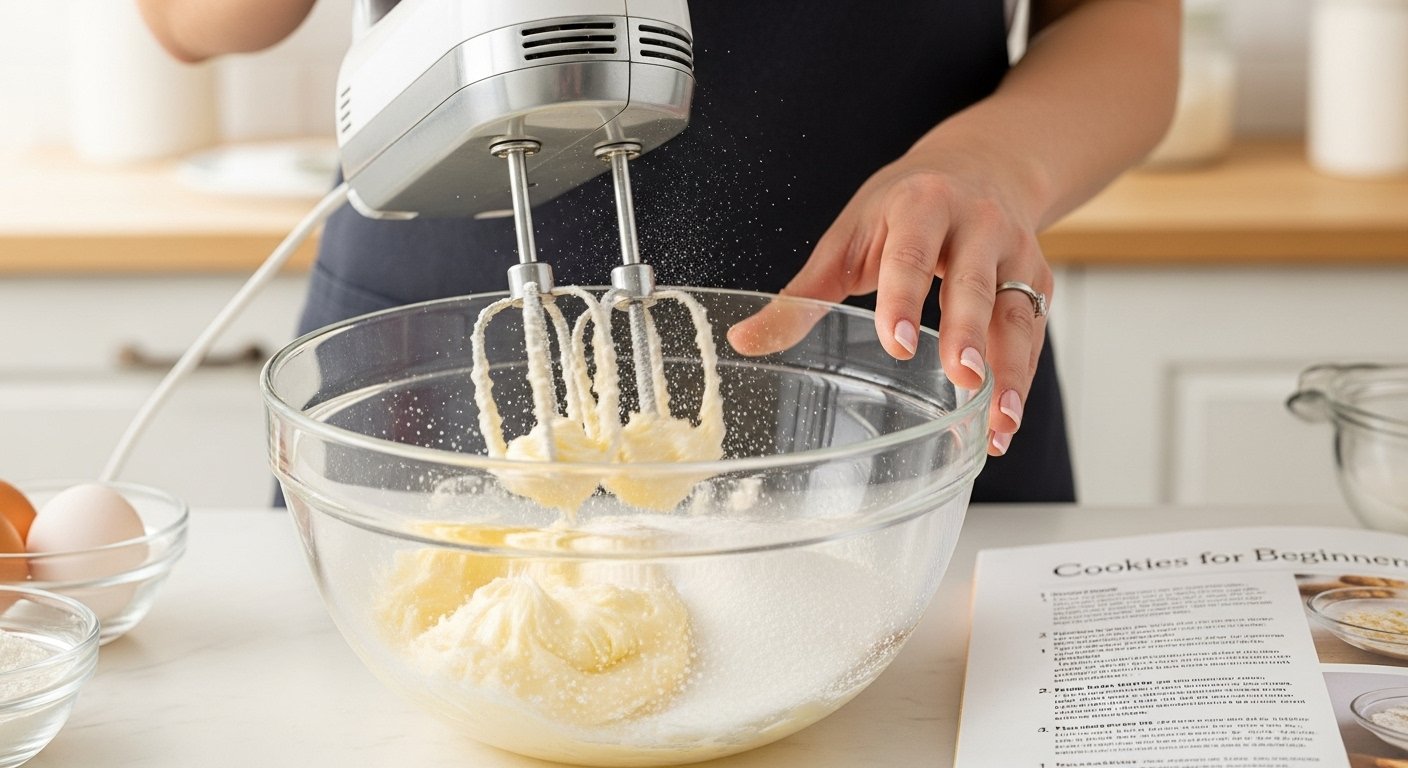
Step-by-Step Guide: How to Bake Cookies for Beginners
Now that you have your tools and ingredients ready, let’s dive into the practical steps. Following these instructions carefully will set you up for success in baking perfect cookies every time.
1. Preheat Your Oven Temperature
This first step is crucial. Always preheat your oven temperature fully before putting in your cookies. Most cookie recipes call for an oven temperature between 350°F (175°C) and 375°F (190°C). A properly preheated oven ensures even baking from the start. Consider investing in an oven thermometer to verify your oven’s accuracy, as many can run hotter or colder than their setting.
2. Sift Dry Ingredients (If Required)
In a medium bowl, whisk together your dry ingredients: all-purpose flour, baking soda, and any salt called for in the recipe. Sifting isn’t always essential, but it helps to combine them evenly and removes any lumps. For a detailed explanation of why and when to sift flour, refer to our guide on Why Sift Flour? Science Explained. This step ensures uniform distribution of leavening agents.
3. Cream Butter and Sugar
In a large mixing bowl, combine the softened unsalted butter with your granulated sugar and brown sugar. Using an electric mixer, beat them together on medium speed until the mixture is light, fluffy, and pale in color. This process, known as creaming, incorporates air into the butter, which contributes to the cookie’s rise and tender texture.
4. Add Eggs and Vanilla
Crack your room temperature eggs into the creamed butter and sugar mixture, one at a time. Beat well after each addition to fully incorporate. Stir in the vanilla extract. Scrape down the sides of the bowl often to ensure everything is well combined. This step helps create a stable emulsion.
5. Combine Wet and Dry Ingredients
Gradually add the dry ingredient mixture to the wet ingredients, mixing on low speed until just combined. Be careful not to overmix batter or dough! Overmixing develops the gluten in the flour too much, leading to tough, dense cookies. Stop mixing as soon as you no longer see streaks of flour.
6. Fold in Mix-ins (e.g., Chocolate Chips)
If your recipe includes mix-ins like chocolate chips, nuts, or dried fruit, gently fold them into the dough with your rubber spatula. Distribute them evenly throughout the cookie dough tips. This simple step prevents your cookies from being unevenly textured.
7. Scoop and Space Dough
Use a cookie scoop to portion out uniform balls of dough. Place them on your parchment-lined baking sheets, leaving enough space between them (about 2 inches) to allow for spreading. This prevents them from merging into one giant cookie. Many recipes also suggest chilling dough for at least 30 minutes. Chilling dough helps prevent spreading and deepens flavor.
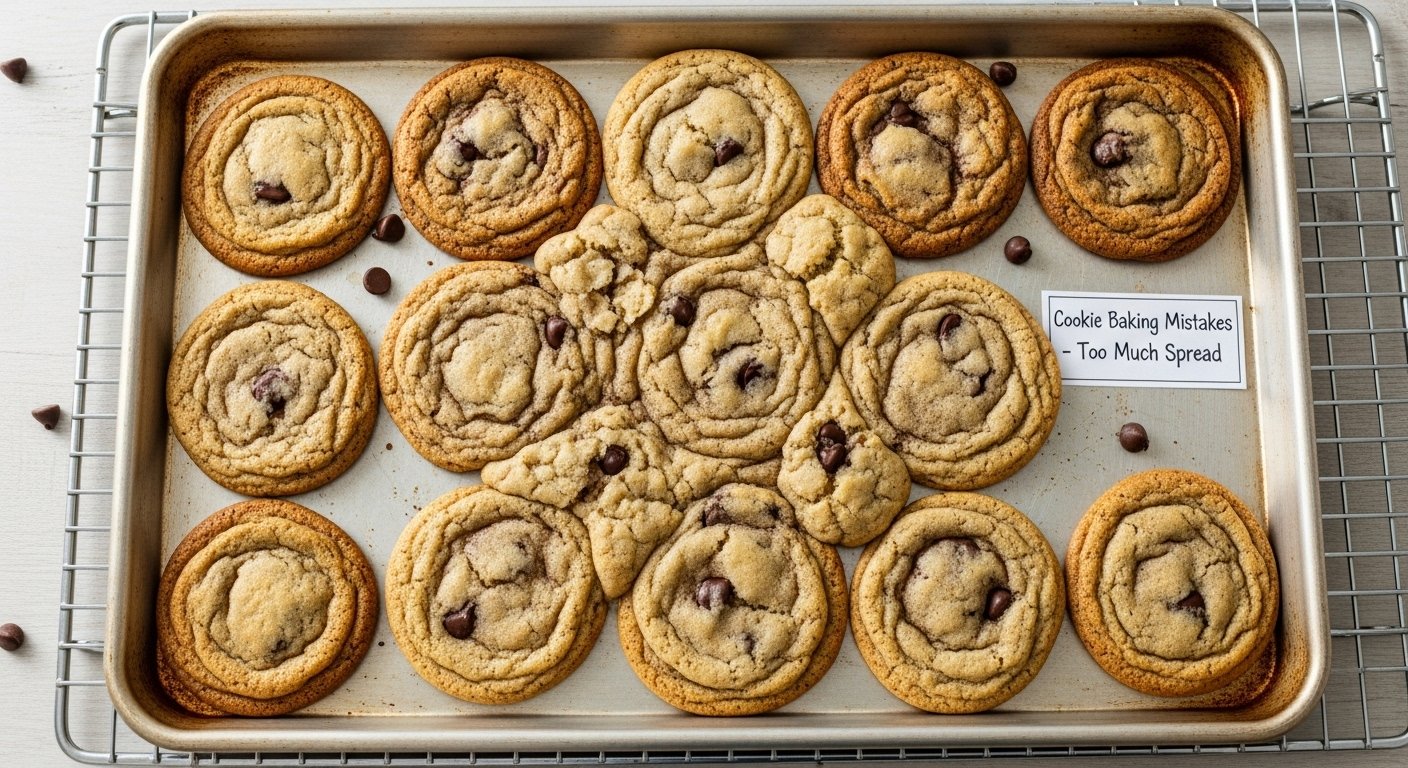
Troubleshooting Common Cookie Baking Mistakes
Even experienced bakers face challenges sometimes. Understanding common cookie baking mistakes will help you diagnose and fix issues quickly. Don’t get discouraged if your first batch isn’t absolutely perfect. Remember, practice makes perfect in baking!
Why Are My Cookies Flat or Spreading Too Much?
Flat cookies are a frequent complaint. Several factors can cause this. Not measuring ingredients correctly is a primary culprit. Too little flour or too much sugar/butter can lead to excessive spreading. Additionally, if your butter was too soft or melted, it won’t hold enough air during creaming, causing the cookies to collapse. An oven temperature that’s too low will also contribute to spreading before the cookies set. Finally, skipping the step to chill dough can result in flatter cookies. Consider placing your dough in the refrigerator for at least 30 minutes before baking to firm up the fat.
Cookies That Are Too Hard or Dry
Overbaking is the number one cause of dry, hard cookies. Cookies continue to cook slightly even after being removed from the oven. Pull them out when the edges are set and lightly golden, but the centers still look a little soft. Overmixing batter or dough can also create tough cookies by over-developing the gluten. Using too much flour, as mentioned earlier, is another common error. For insights into other baking woes, check out Why Are Cakes Dry? Baking Mistakes Solved!.
Understanding True Oven Temperature
Your oven’s thermostat might not be perfectly accurate. This means the temperature you set might not be the true oven temperature inside. A simple oven thermometer can help you verify if your oven is running hot or cold. This knowledge allows you to adjust your baking time or temperature accordingly, preventing cookies from burning or baking unevenly.
The Dangers of Overmixing and Overbaking
These two mistakes are incredibly common for beginners. Overmixing cookie dough develops the gluten, resulting in a tough texture. Always mix just until the ingredients are combined. Overbaking, on the other hand, extracts too much moisture from the cookies, making them dry and crumbly. Remember to remove cookies when they are still slightly soft in the center; they will firm up as they cool on the baking sheet.
Making Substitutions Without Understanding the Science
While baking can be an art, it’s also a science. Common baking mistakes include making substitutions without understanding the science behind them. For example, swapping baking soda for baking powder, or vice versa, will drastically change your cookie’s texture and spread. These leavening agents react differently. Altering fat or sugar content significantly impacts the final product. Stick to the recipe, especially as a beginner, until you grasp the role of each ingredient.
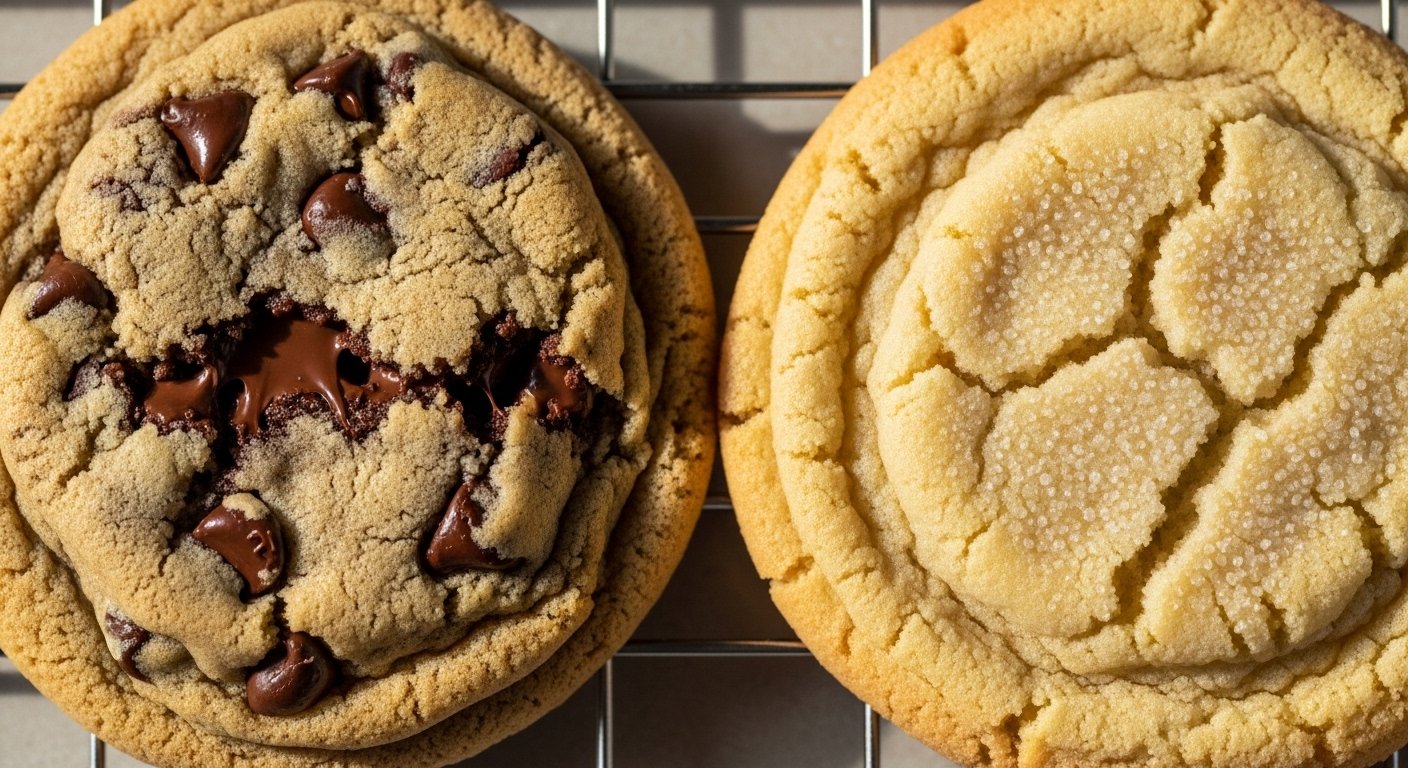
Achieving Your Desired Cookie Texture
The perfect cookie texture is often a matter of personal preference. Do you crave a soft, chewy center or a delicate crispness? Understanding how ingredients and techniques influence texture can help you bake your ideal cookie. How do I make cookies soft and chewy, or perfectly crispy?
Secrets to Chewy Cookies
To make chewy cookies, several factors are key. Using more brown sugar than granulated sugar helps, as brown sugar contains molasses, which adds moisture and creates a softer crumb. Slightly underbaking your cookies (removing them from the oven when the edges are set but the centers are still quite soft) is also essential. Additionally, melted butter can contribute to a chewier texture. Chilling dough before baking also helps keep the cookies thicker, retaining more moisture for a chewy result.
Tips for Crispy Cookies
If you prefer crispy cookies, here are some tips. Increase the proportion of granulated sugar, which promotes spreading and crispness. Using an egg yolk (instead of a whole egg) or an extra egg white can also contribute to a crispier texture. Baking the cookies for a minute or two longer until they are golden-brown all over will help achieve that desired snap. Using melted butter might also lead to crispier edges, especially if combined with chilling the dough. A higher oven temperature for a shorter time can also help achieve a crisp exterior with a soft interior.
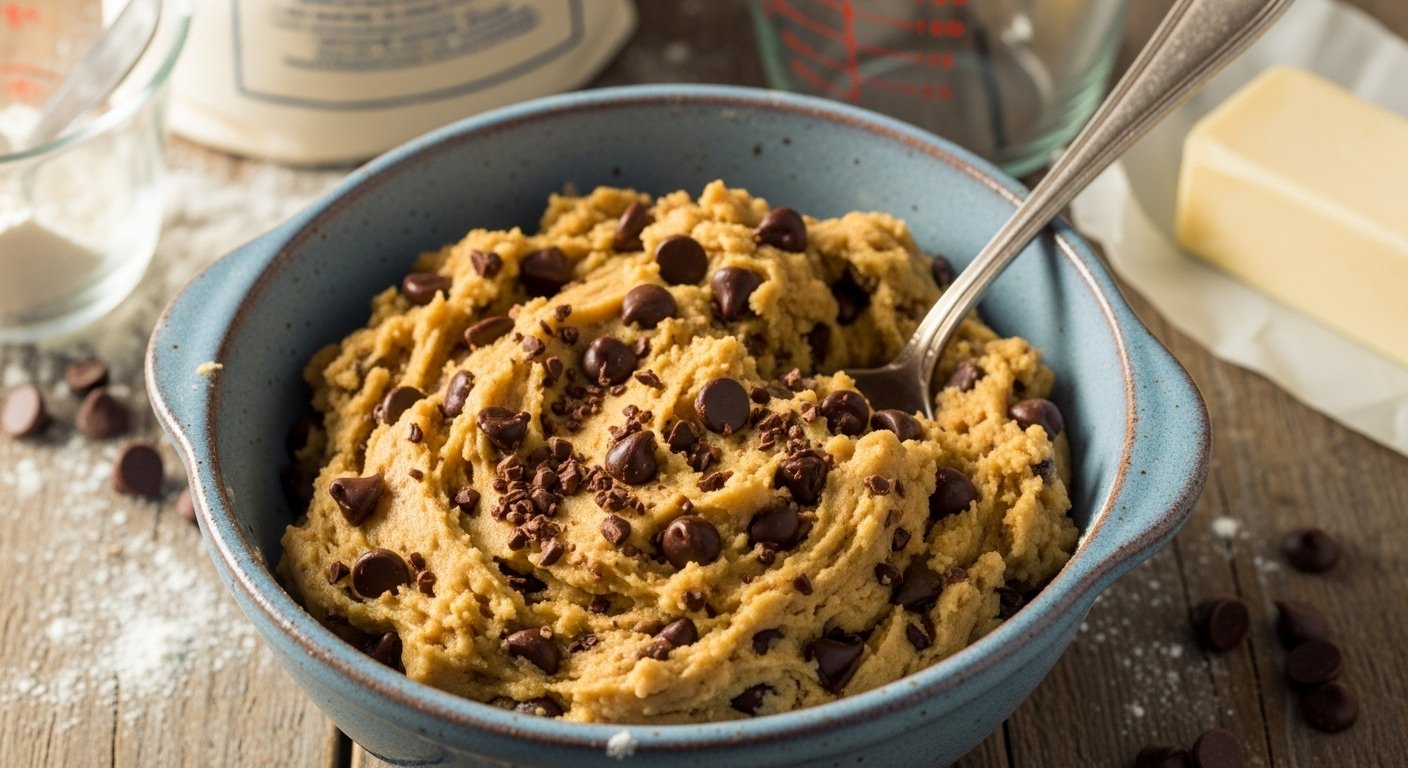
Easy & Delicious: Beginner-Friendly Cookie Recipes
Starting with simple, reliable recipes is the best approach for beginners. These no-fail cookie recipe options are designed to build your confidence and deliver fantastic results. These are some of the best cookie recipes for beginners.
Classic Chocolate Chip Cookies
A simple chocolate chip cookie recipe is a cornerstone of beginner cookie baking tips. This recipe yields a perfect balance of chewy and soft with slightly crispy edges.
#### Simple Chocolate Chip Cookie Recipe
Here’s how to make them:
Easy Sugar Cookies
Sugar cookies are another fantastic option for easy cookie recipes for kids and adults alike. This simple sugar cookie recipe is often a no-chill recipe, meaning you can bake them right away!
#### Basic Sugar Cookie Recipe (No-Chill)
Follow these steps:
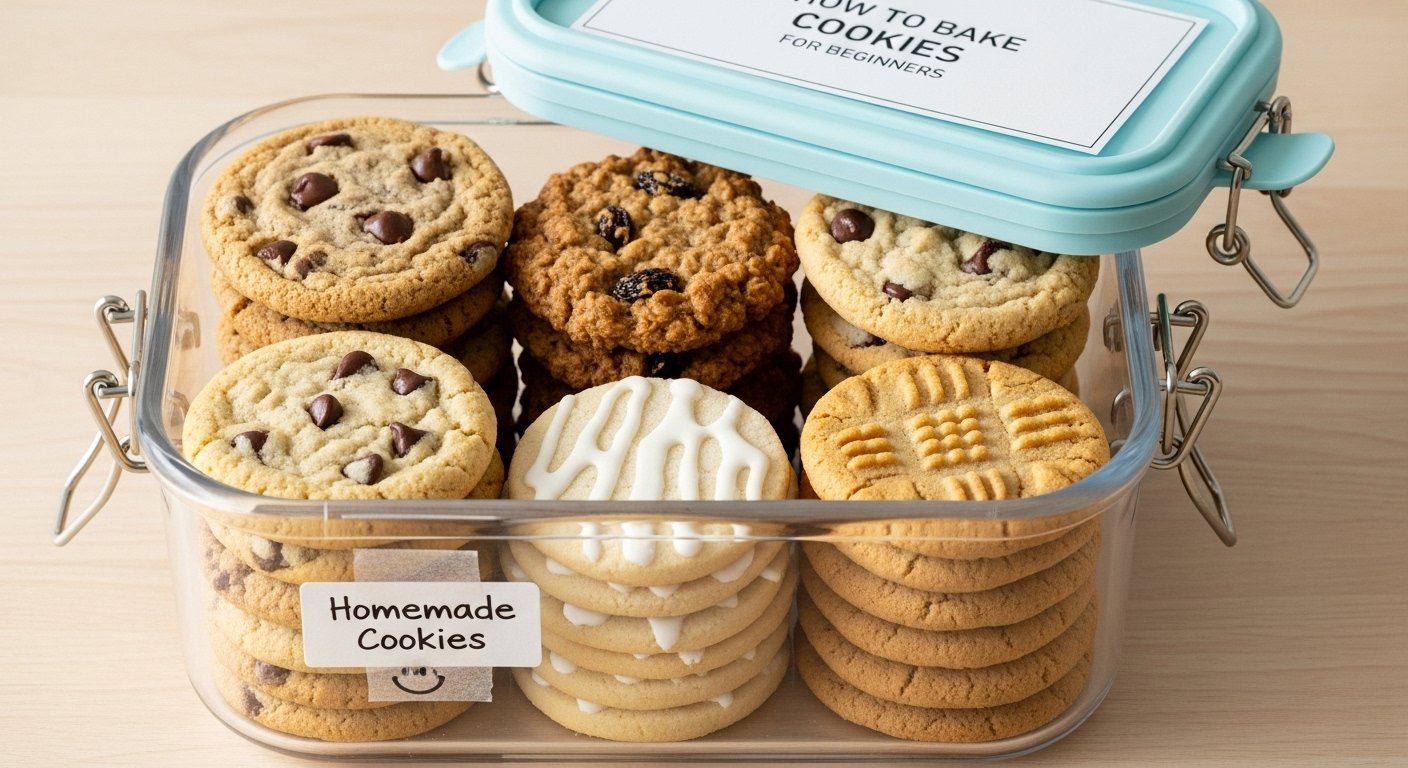
Storing Your Homemade Cookies for Freshness
After all your hard work, you want your delicious homemade cookies to stay fresh for as long as possible. Proper storage is key to maintaining their taste and texture. How do I store cookies to keep them fresh?
Most cookies store well at room temperature in an airtight container for up to 3-5 days. To maintain their texture, store crisp cookies separately from chewy ones. 7] For longer storage, cookies can be frozen. Place cooled cookies in a single layer on a baking sheet to freeze, then transfer them to an airtight freezer-safe bag or container. They can be safely frozen for 6-12 months. [3] Ensure you label them with the date! For more detailed guidance on safe storage, consult resources like [Storing Bread and Baked Products – Food Safety.
Mastering Cookie Baking: Your Journey Begins
Baking perfect cookies is an achievable goal for any beginner. You’ve now gained valuable insights into the essential tools, basic ingredients, and critical techniques that ensure success. From understanding the nuances of room temperature ingredients to mastering the creaming method, each step builds confidence. Remember that common baking mistakes, such as incorrect measurements or overmixing, can easily be avoided with careful attention. By applying these beginner cookie baking tips, you can consistently create delicious, perfectly textured cookies. So, gather your ingredients, preheat your oven, and enjoy the rewarding process of baking your very own homemade treats!
